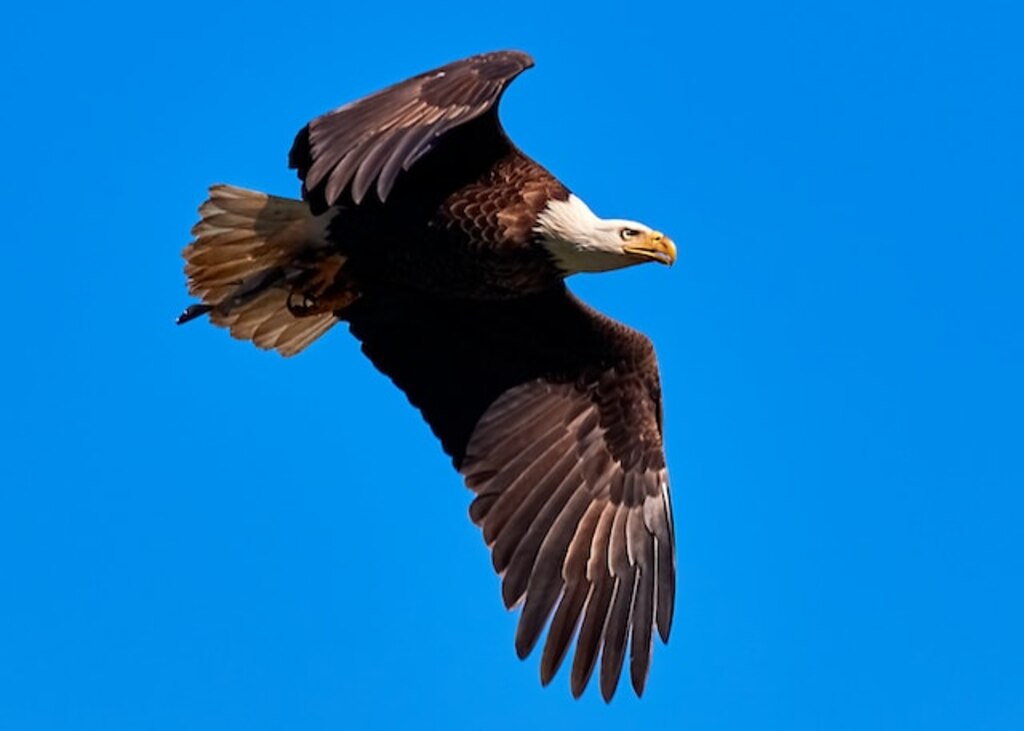How do eagles fly? The majesty of their aerial displays is a sight to behold. In this captivating article, we unravel the complex mechanics behind their flight.
From their powerful wings and keen eyesight to their unique adaptations, discover how these birds of prey effortlessly soar through the skies.
Join us as we explore the anatomy, behavior, and conservation of these magnificent creatures. Get ready for an exhilarating journey through the captivating world of eagle flight!
Table of Contents
- 1 Key Takeaways
- 2 Overview of Eagle Anatomy
- 3 How Do Eagles Fly
- 4 Types of Flight
- 5 How Eagles Generate Lift
- 6 Adaptations for Flight
- 7 Soaring Techniques
- 8 Hunting Strategies
- 9 Migration Patterns
- 10 Comparison to Other Birds
- 11 The Role of Eagles in Ecosystems
- 12 Threats to Eagle Populations
- 13 Conservation Efforts
- 14 Frequently Asked Questions
- 15 Conclusion
- 16 Author
Key Takeaways
- Eagles have unique adaptations for flight, including a wing structure designed for maximum efficiency and the ability to manipulate wing shape and angle for lift and energy efficiency.
- Eagles use several adaptations for soaring flight, such as thermals, ridge lift, and dynamic soaring, and can detect and use thermals to gain altitude without flapping.
- Eagles are opportunistic hunters with incredible eyesight, capable of spotting prey from great distances and diving towards it at high speeds.
- Eagles play a crucial role in ecosystems as controllers of populations and scavengers, but are threatened by habitat loss, pollution, and hunting, making conservation efforts crucial for their survival.
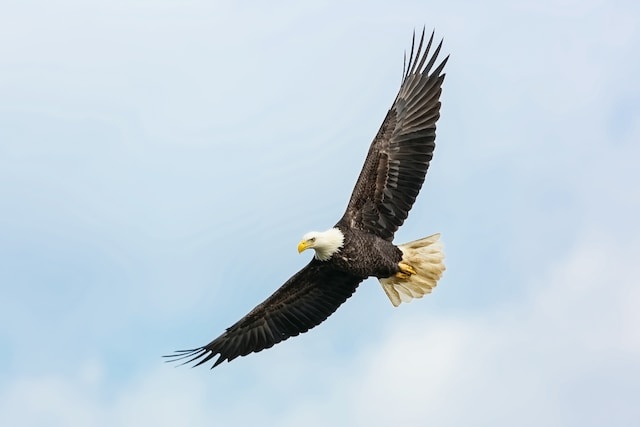
Overview of Eagle Anatomy
A thorough understanding of the anatomy of eagles is essential in comprehending the mechanics of their flight.
The wing structure of eagles is designed for maximum efficiency, with its primary feathers acting like miniature airfoils that produce lift.
The wings are long and broad, allowing for the surface area needed to generate lift and maintain altitude.
The aerodynamics of eagle flight are complex, with the bird able to adjust its wing shape and angle to generate lift and control its speed.
The eagle’s strong chest muscles provide the power needed to flap its wings, while its tail acts as a rudder to help steer in flight.
All of these elements work together to create the majestic flight of the eagle.
Understanding the anatomy and mechanics of eagle flight is crucial in appreciating the different types of flight exhibited by these magnificent birds.
How Do Eagles Fly
Eagles fly by utilizing their impressive wingspan, muscular bodies, and specialized flight adaptations.
Their broad wings provide lift and stability, allowing them to soar at great heights. By using thermal updrafts and air currents, eagles conserve energy during flight.
Their strong flight muscles generate power, enabling them to maneuver swiftly and dive at incredible speeds to catch prey.
Additionally, their keen eyesight helps them spot targets from long distances, making them skilled hunters in the sky.
Overall, eagles’ anatomy and flight strategies enable them to soar gracefully and efficiently through the air.
Types of Flight
Various modes of aerial motion executed by eagles include soaring, flapping, and gliding, much like an accomplished ballet dancer who performs a variety of graceful movements.
Eagles have different types of wings that allow them to perform these different types of flight.
Their long and broad wings are perfect for soaring, which is the most energy-efficient way of flying.
Flapping flight is used when eagles need to gain altitude quickly or when they need to fly against strong winds. Gliding is when eagles use the air currents to stay aloft without flapping their wings.
These modes of flight are made possible by the aerodynamic principles that govern the flow of air around the wings.
By manipulating the shape and angle of their wings, eagles can generate lift and stay airborne for long periods of time.
Understanding how eagles generate lift is crucial to gaining a deeper appreciation of their impressive flight abilities.
How Eagles Generate Lift
Eagles generate lift by manipulating the shape and angle of their wings, which allows them to stay aloft for extended periods of time using the energy-efficient mode of soaring flight.
The wing structure of eagles is designed with a combination of lightweight feathers and strong bones, which allows them to withstand the forces of flight.
Additionally, the shape of their wings is key to their ability to generate lift. Their wings are broad and flat, with a slightly curved leading edge and a tapered trailing edge.
This shape allows air to flow smoothly over the wings, creating a low-pressure area above the wing and a high-pressure area below.
This pressure differential generates lift, allowing the eagle to stay in the air with minimal effort.
Eagles also use aerodynamic principles to their advantage, such as adjusting the angle of their wings or tail to control their altitude and speed.
As the eagle soars through the air, it is easy to imagine the feeling of freedom and the awe-inspiring beauty of nature.
From soaring high above the mountains to gliding effortlessly over the ocean, eagles embody the freedom that we all desire.
In the subsequent section about adaptations for flight, we will explore the unique characteristics of eagles that allow them to excel in their aerial environment.
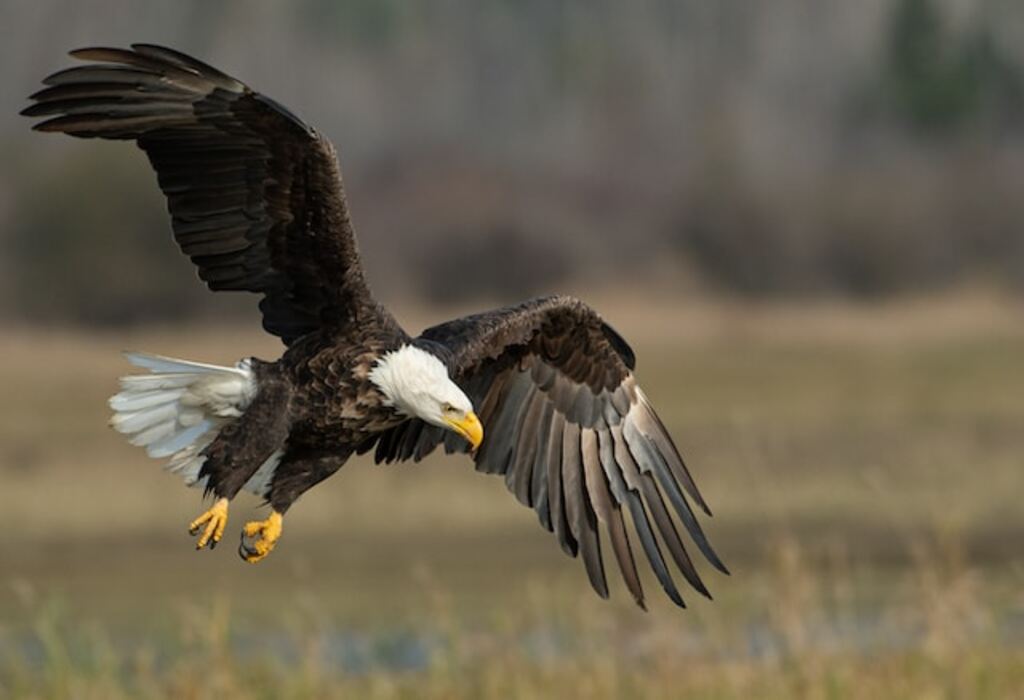
Adaptations for Flight
The unique physical characteristics of birds of prey make them highly adapted for their aerial lifestyle. Eagles, for instance, have several adaptations that enable them to soar effortlessly through the skies.
One such adaptation is their hollow bones, which are lightweight yet strong enough to support the bird’s body weight.
This feature reduces the bird’s overall weight, making it easier for them to fly and maneuver. Additionally, the shape of their wings plays a crucial role in their flight.
Eagles have broad, powerful wings that provide lift and stability during flight. This wing shape allows them to glide for long distances without flapping their wings, conserving energy during flight.
To evoke emotion in the audience, consider the following table:
| Adaptations | Functions | Benefits |
|---|---|---|
| Hollow bones | Lightweight | Easier flight |
| Broad wings | Lift and stability | Efficient gliding |
These adaptations not only make eagles successful hunters but also evoke a sense of freedom in those who admire them.
The combination of these physical features and their soaring techniques make eagles one of the most majestic creatures in the sky.
Speaking of soaring techniques, eagles have developed several ways to stay aloft, which we will explore in the next section.
Soaring Techniques
This section will discuss the various soaring techniques employed by birds during flight, including thermals, ridge lift, and dynamic soaring.
Thermals are columns of rising warm air that birds use to gain altitude without expending much energy.
Ridge lift is a phenomenon where birds use wind currents that are deflected upwards by the shape of a ridge or mountain to gain altitude.
Dynamic soaring involves birds alternating between ascending and descending air currents to gain speed and altitude.
Understanding these techniques can provide insights into the strategies that birds use to navigate the skies efficiently.
Thermals
Thermals, which are rising columns of warm air, play a crucial role in allowing birds like eagles to soar and glide effortlessly through the sky.
When the sun heats up the ground, the air above it rises, creating a thermal. As the warm air rises, it cools and condenses, forming clouds.
Eagles can detect and use thermals to gain altitude without flapping their wings, saving energy and allowing them to fly for longer periods of time.
The importance of thermals for eagle flight is evident in the way they navigate their environment. Eagles will often circle in a thermal to gain altitude before gliding off to their next destination.
In order to fully understand thermals, it is useful to compare them with another type of lift: ridge lift. The following section will explore how eagles utilize ridge lift to continue their effortless flight.
Ridge Lift
Utilizing the powerful force of updrafts caused by the wind hitting a mountain or hill, ridge lift provides an exhilarating and efficient way for soaring birds to stay aloft for hours on end.
This gliding technique is particularly useful for eagles as they can conserve energy while searching for prey or traveling long distances.
Thermal currents are often found near ridges, and eagles can use them to gain altitude and then glide along the ridge, riding the upward lift created by the wind.
As they glide, eagles can also make small adjustments to their wings and tails to maintain their position in the lift.
This technique allows them to soar with minimal effort, and they can cover great distances while surveying their surroundings or searching for food.
Dynamic soaring, the next technique we will discuss, takes this technique to the next level, allowing birds to harness the power of wind shear to soar even higher and faster.
Dynamic Soaring
Dynamic soaring is a technique used by some birds to gain altitude and speed by utilizing wind shear.
This technique involves flying in a figure-eight pattern, taking advantage of the changing wind patterns at different altitudes.
By flying into the wind and then turning downwind, the bird is able to gain speed and altitude.
This is possible because the bird’s wings create lift as they move through the air, and the wind shear creates an additional lift force on the wings.
This technique is particularly useful for birds that migrate long distances and need to conserve energy, as it allows them to cover great distances with minimal effort.
In addition to aiding in navigation, dynamic soaring is also used by some birds, such as eagles, in their hunting strategies.
By using this technique, eagles can gain altitude quickly and then dive down at high speeds to catch their prey.
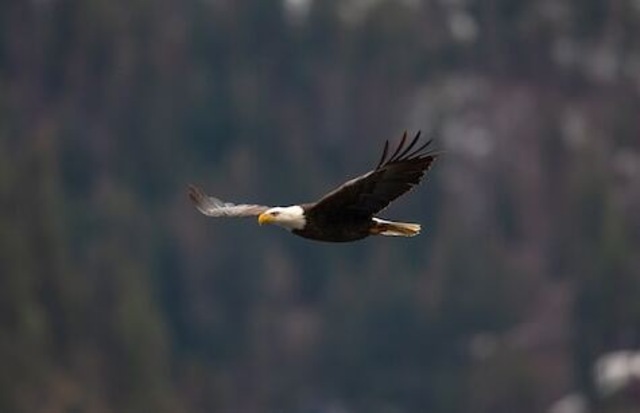
Hunting Strategies
One effective hunting strategy employed by eagles involves patiently observing their prey from a high vantage point before swooping down like a lightning bolt to snatch it up with their powerful talons.
Eagles use their incredible eyesight, which is up to eight times sharper than the human eye, to scan the landscape for potential prey.
They are able to spot prey from great distances and can even see ultraviolet light, which helps them to detect the urine trails and feather patterns of small mammals.
Once an eagle has identified its prey, it will fly above it in circles, using the thermals to gain altitude and conserve energy. This is known as kettling.
The eagle will then dive towards the prey at high speeds, reaching up to 200 miles per hour, and grab it with its sharp talons.
Eagles are opportunistic hunters and will take advantage of any prey that presents itself, from fish to small mammals to other birds.
Their hunting strategies are essential for their survival, and they have evolved to be experts in their craft.
Moving on to migration patterns, eagles have unique patterns of travel that allow them to travel long distances in search of food and breeding grounds.
Migration Patterns
Migration patterns of eagles involve long-distance travel in search of food and breeding grounds, which is crucial for their survival.
These majestic birds of prey have been known to travel thousands of miles on their migration routes, with some species crossing entire continents.
Their migration is influenced by various environmental factors such as weather patterns, availability of food, and breeding conditions.
During migration, eagles use thermals and updrafts to conserve energy and cover great distances.
Watching these birds soar gracefully through the sky, one cannot help but feel a sense of awe and admiration for their freedom and independence.
It is fascinating to see how eagles navigate the vast distances and challenges that lay ahead on their journey, highlighting their incredible physical and mental abilities.
As we delve deeper into the world of eagles, we can gain a greater appreciation for the importance of their migration patterns on their survival and the natural world as a whole.
In the next section, we will compare the unique characteristics of eagles to those of other birds.
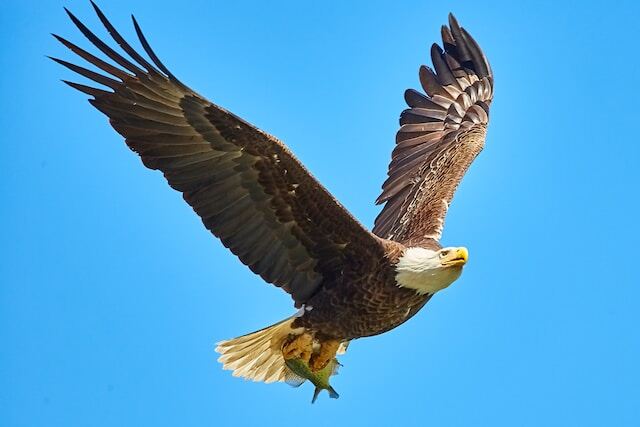
Comparison to Other Birds
When comparing eagles to other birds, several key points come to mind. Size and weight are important factors to consider, as eagles are among the largest birds of prey in the world.
Flight techniques also differ between species, with some birds utilizing soaring and others flapping their wings constantly.
Finally, adaptations and specializations such as talons and beaks play a crucial role in a bird’s survival and hunting capabilities. These factors will be explored in depth when comparing eagles to other birds.
Size and Weight
The size and weight of eagles play a crucial role in their ability to soar through the skies with grace and efficiency. These majestic birds are known for their impressive hunting abilities, which are largely determined by their size and weight.
Here are three key ways in which size and weight impact an eagle’s flight:
- Lift: Eagles need to be able to generate enough lift to get off the ground and stay in the air. The larger and heavier the bird, the more lift it needs to produce. Eagles have evolved to have large wingspans and powerful muscles that allow them to generate the lift they need to take to the skies.
- Speed: Eagles are fast fliers, able to reach speeds of up to 200 miles per hour during a dive. However, their size and weight can also impact their speed. Larger eagles may struggle to reach the same speeds as smaller ones due to their size and the drag caused by their larger bodies.
- Prey preferences: The size and weight of eagles also impact their prey preferences. Larger eagles, such as the golden eagle, are able to take down larger prey such as deer and antelope, while smaller eagles may focus on smaller prey such as rodents or fish.
Understanding the importance of size and weight in eagle flight is essential for appreciating these magnificent creatures and their incredible abilities. Moving on from this subtopic, we can now explore the specific flight techniques that eagles use to stay aloft and hunt their prey.
Flight Techniques
One of the most fascinating aspects of eagle behavior involves their unique flight techniques that allow them to navigate their environment with incredible precision and grace.
Eagles have several flight advantages, including their large wingspan, powerful chest muscles, and broad tails that enable them to soar effortlessly for hours on end.
They also have excellent eyesight, which allows them to spot prey from great distances and navigate obstacles such as trees and mountains with ease.
In fact, eagles are able to adjust their wing shape and angle to take advantage of air currents and thermals, which helps them to conserve energy and remain aloft for extended periods.
Moreover, eagles are skilled at navigating through tight spaces and narrow gaps, using their agility and sharp talons to grab onto branches or prey.
Overall, the unique flight techniques of eagles are a testament to their adaptability and specialization in the wild, allowing them to thrive in even the most challenging environments.
As we move into the next section about adaptations and specializations, we will explore how eagles have evolved to become such exceptional aviators.
Adaptations and Specializations
Eagles’ unique adaptations and specializations have allowed them to excel as aviators in their environment.
Their wings are large and broad, providing lift and allowing them to soar over long distances with little effort.
The feathers on their wings are also specially adapted to provide stability, enabling them to glide and maneuver with great precision.
Eagles have keen eyesight, allowing them to spot prey from great distances, and they also have sharp talons and beaks that are designed for hunting and killing.
Behavioral habits also contribute to their successful flight, such as their ability to fly in formation, which conserves energy, and their use of thermals, which provide lift.
Environmental influences, such as wind patterns and air currents, also play a role in their flight.
By adapting to their environment in these ways, eagles are able to thrive and maintain their position as top predators in their ecosystems.
As we explore the role of eagles in ecosystems, we will see how their unique adaptations and specializations contribute to the balance of nature.
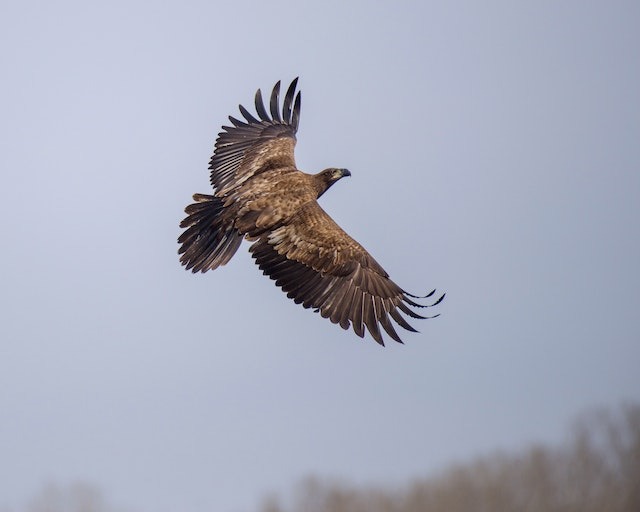
The Role of Eagles in Ecosystems
Ecosystems rely on the presence of predators, such as eagles, to maintain a balance within the food chain, preventing overpopulation of prey species and promoting biodiversity.
Eagles play a crucial role in their ecosystems, as they help to control populations of smaller animals, such as rodents and fish.
Their hunting behavior, which involves using their sharp talons and strong beaks to catch and kill prey, ensures that these species do not become too numerous and upset the balance of the ecosystem.
In addition, eagles also act as scavengers, consuming dead animals and helping to recycle nutrients back into the ecosystem.
Unfortunately, eagle populations have been threatened by a variety of factors, including habitat loss, pollution, and hunting.
These threats have led to declines in some eagle populations, underscoring the importance of conservation efforts to protect these magnificent birds.
Threats to Eagle Populations
Habitat loss, pollution, and hunting pose significant threats to the populations of these majestic birds of prey.
Eagles require vast territories to obtain their food, build their nests, and raise their young.
However, human activities such as deforestation, urbanization, and agriculture have led to the destruction and fragmentation of their habitats.
In addition, eagles are often hunted for their feathers, talons, and other body parts that are used for cultural or medicinal purposes.
Poaching also occurs for the illegal trade of live eagles as pets or for falconry.
These threats have resulted in a decline in eagle populations worldwide.
Conservation efforts are crucial to protect these iconic birds and their habitats for future generations.
Conservation Efforts
Conservation efforts have been implemented to mitigate the threats faced by eagle populations around the world.
These efforts include habitat restoration, where natural habitats are restored and protected to provide a suitable environment for eagles to thrive.
Community involvement is also important, as it encourages locals to participate in conservation efforts and helps raise awareness about the importance of protecting eagles.
In addition, some organizations have implemented captive breeding programs, which aim to increase the number of eagles in the wild.
Finally, regulations have been put in place to limit human activities that pose a threat to eagle populations, such as hunting and habitat destruction.
These conservation efforts are crucial in ensuring the continued survival of eagle populations and maintaining the balance of our ecosystems.
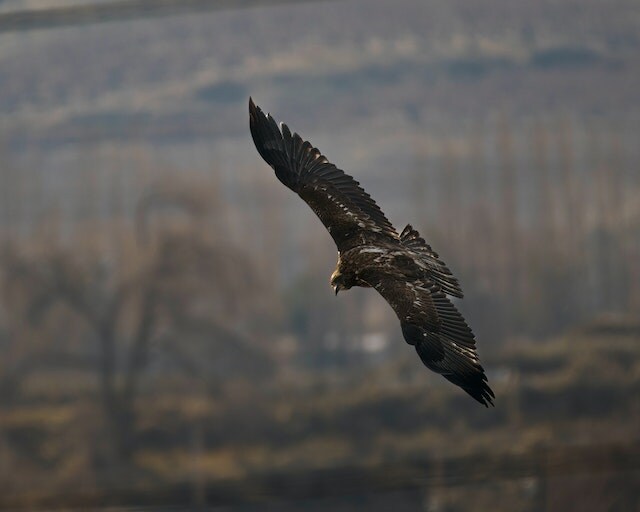
Frequently Asked Questions
What is the lifespan of an eagle?
The lifespan of eagles varies among species, ranging from 15-30 years. Breeding habits also vary, with some eagles mating for life while others engage in polygyny. Eagles face threats such as habitat loss and hunting, which can impact their lifespan.
How do eagles mate and reproduce?
Eagles exhibit complex mating rituals and nesting behaviors. Courtship involves aerial displays and vocalizations. Once a pair has formed, they build a large nest and mate for life. This monogamous relationship reinforces the eagles’ strong sense of freedom and independence.
Eagles form hierarchical social structures with dominant individuals occupying higher ranks and having preferential access to food and mates. Communal roosts are used for socializing and sharing information, with individuals of different ages and sexes congregating together.
Do eagles have any natural predators?
In the predator-prey dynamics, eagles have natural predators such as bears, wolves, and bobcats. However, eagles have developed hunting strategies such as speed, agility, and keen eyesight to avoid becoming prey themselves.
How do eagles communicate with each other?
Eagles communicate with each other through a range of vocalizations, including calls, screams, and whistles. They also use hunting strategies such as cooperative hunting, which involves communication and coordination between individuals.
Conclusion
In conclusion, the flight of eagles is a remarkable display of adaptation and skill. Their unique anatomy, including their large wingspan and strong muscles, allow them to generate lift and soar through the air with ease.
These adaptations have allowed eagles to become apex predators in many ecosystems, playing an important role in maintaining a balance of species.
However, human activities such as habitat destruction and hunting have threatened eagle populations, leading to conservation efforts to protect these magnificent birds.
It is important to recognize the significance of eagles in our ecosystems and to take action to ensure their continued survival.
Through conservation efforts, we can help protect their habitats and promote sustainable practices that benefit both eagles and other species.
The flight of eagles serves as a reminder of the beauty and complexity of the natural world, and the importance of preserving it for future generations to enjoy.

